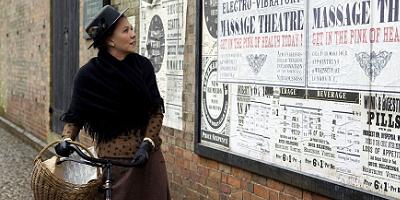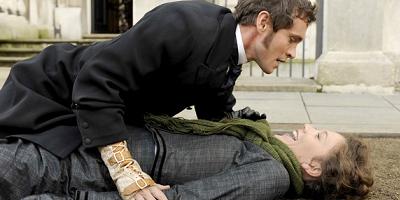Hysteria

The late 19th century, as Hysteria is eager to convey, was a time of great social and scientific upheaval. Whether it was the advent of electrical power in the home, the introduction of antiseptic in medicine, or the early beginnings of the Suffragette movement, it’s unlikely a day went by in Victorian high society without somebody expressing their belief in one revolutionary movement or another. In films, however, we don’t have days, only minutes; mere moments to suggest that this was a society in the process of major change – and what better way to achieve it than to have the characters literally say so? Constantly. Indeed, in the spirit of starting as it means to go on, Hysteria establishes its setting with all the subtlety of a sledgehammer. “It’s the 1880s,” young doctor Mortimer Granville (Dancy) exclaims in disbelief, “we’re supposed to be in the midst of a medical revolution!”
This outburst, occurring during an argument with his superior regarding the validity of germ theory (“poppycock”, the older physician insists), soon finds Mortimer fired, setting off a chain of events that will change not only his career, but also his social outlook. Finding a new post at the office of Dr. Robert Dalrymple (Pryce), our lead finds himself introduced not only to his employer’s lovely young daughter, Emily (Jones), but also to the concept of ‘hysteria’. A debilitating plague of the womb that Dalrymple believes may be affecting at least half the females in London, hysteria triggers behaviour so irrational that women have started trying to leave the kitchen, causing bafflement and horror amongst the city’s men. Cue the entry of Dr Dalrymple’s other daughter, Charlotte (Gyllenhaal), a lady with wild opinions on the subject of equality. No longer will women and the working classes be treated like second class citizens, Charlotte asserts – after all, “we’re in the midst of a social revolution!”

With these two plot threads laid out alongside that of Mortimer’s flatmate Edmund St. John-Smythe (Everett, playing a camp version of Family Guy’s James William Bottomtooth) – a wealthy heir fascinated by all things electrical – all that remains is for the audience to watch and chortle as the characters’ purposes become inevitably intertwined. With each of the central arcs offering plenty of ‘weren’t people silly back then’ moments, the film’s gags hinge mainly on the naivety of the past – an idea that, although fine in principal, quickly wears thin. From Edmund’s excitement over his new telephone (“imagine if everyone had one!”), to Mortimer teasing Charlotte that after winning women the vote she may as well “teach them how to fly”, the humour is usually harmless, but never hilarious.

More difficult to reconcile, however, is the film’s approach to its central topic. With Dr. Dalrymple’s signature hysteria treatment – and the genesis of Mortimer’s invention – revolving around the recurring joke that two medical professionals are unwittingly pleasuring women for a living, the closing act’s sudden acknowledgement that diagnosis could, in ‘extreme cases’, actually lead to forced hysterectomy creates something of a tonal shift. For comparison, imagine a stand-up comedian that tells the same “why did the chicken cross the road?” gag for 95 minutes, pausing only to show a brief slideshow of chickens getting hit by trucks. It might make you see the joke differently, but it certainly doesn’t make it any funnier.





Recent Comments